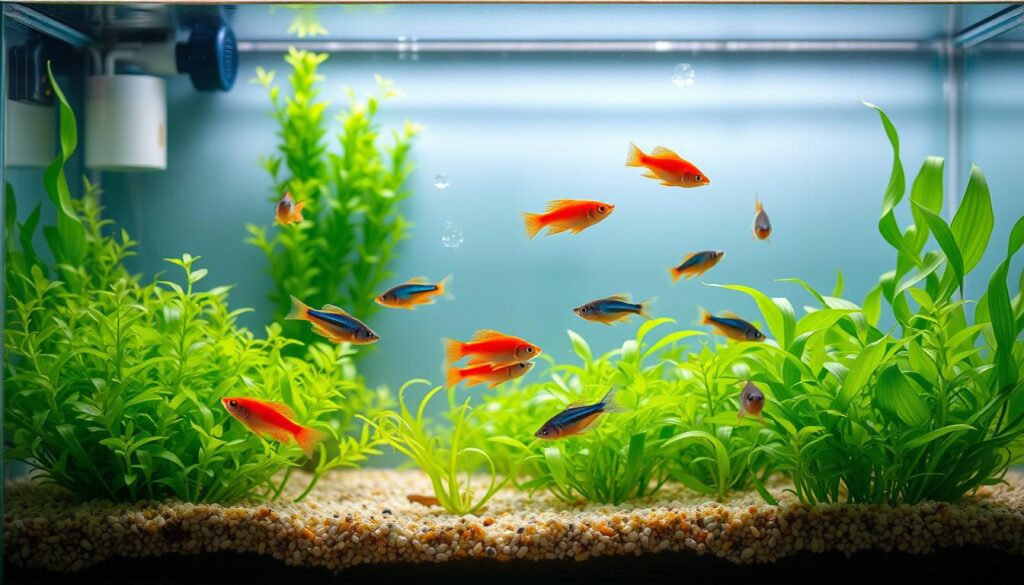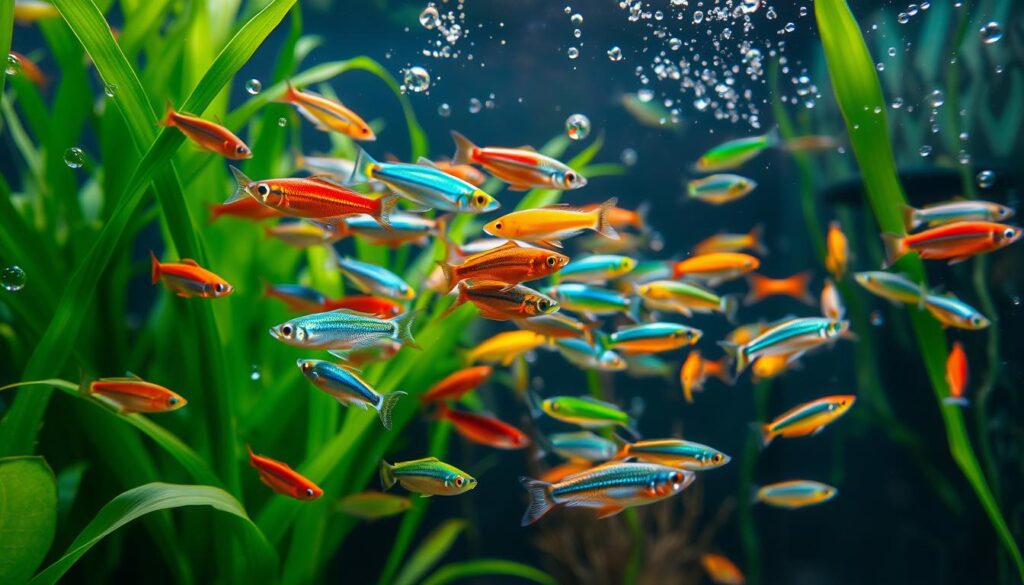Did you know a single neon tetra female can lay up to 150 eggs at once? These tiny, vibrant fish are quite prolific when it comes to reproduction. As an avid aquarist, I find the neon tetra breeding process fascinating. It’s a blend of science and nature that can lead to amazing results.
Neon tetra spawning is quite challenging. These South American fish need specific conditions to breed well. They can start breeding at 12 weeks old and live up to 5-10 years. Setting up the right breeding tank is key for success in tropical fish breeding.
Patience is crucial in breeding neons. It can take up to eight weeks for all the fry to show up. Sometimes, a baby neon will display its iconic colors early, like a living rainbow coming to life!
Key Takeaways
- Neon tetras can lay up to 150 eggs per spawning
- Breeding can start as early as 12 weeks old
- Specific water conditions are crucial for successful breeding
- Fry may continue to appear up to 8 weeks after spawning
- Setting up a proper breeding tank is essential for success
Introduction to Neon Tetras
I’ve always been drawn to the bright colors of neon tetras. These small fish are a favorite among aquarium lovers. Let’s explore their origins, traits, and why they’re loved in aquariums.
Origin and Natural Habitat
Neon tetras come from the Amazon basin. They live in the clear and blackwater streams of Brazil, Colombia, and Peru. To keep them healthy in tanks, it’s important to mimic their natural environment. This is key for their well-being.
Physical Characteristics
Neon tetras are truly beautiful. They have a sleek, torpedo-shaped body with bright colors. A neon blue stripe goes from their nose to the back fin, and a red stripe from mid-body to the tail. These colors make them stand out in any tank.
Popularity in Aquariums
Neon tetras are a top choice for aquariums. They’re small, peaceful, and have amazing colors. They’re often confused with cardinal tetras, but the main difference is the red stripe’s length. Most are bred in fish farms in the Far East and Eastern Europe.
| Characteristic | Neon Tetra | Cardinal Tetra |
|---|---|---|
| Red Stripe Length | From mid-body to tail | Full body length |
| Blue Stripe | From nose to adipose fin | Similar to Neon Tetra |
| Size | Up to 1.5 inches | Slightly larger, up to 2 inches |
| Breeding Difficulty | Challenging | Very challenging |
While neon tetras are popular, breeding cardinal tetras is harder. Both species need special water conditions and expert care to breed in tanks.
Setting Up the Perfect Breeding Tank
Creating the perfect neon tetra breeding conditions is key to success. I’ve learned that copying their natural habitat helps them spawn. Let’s look at the must-haves for a neon tetra tank setup for breeding.
Tank Size and Equipment
I suggest a 12x8x8 inch tank for breeding neon tetras. This size gives enough room for the pair and their babies. You’ll need:
- Corner box filter
- Heater
- Thermometer
- Sponge filter for gentle water movement

Water Parameters
Neon tetras need certain water conditions to breed well. Keep the water:
| Parameter | Ideal Range |
|---|---|
| pH | 5.0-6.0 |
| Hardness | 1-2 dGH |
| Temperature | 72-75°F (22-24°C) |
Lighting and Decoration
Use dim lighting to mimic their natural breeding spots. I cover three tank sides with dark paper to reduce light. For decoration, I add:
- Java moss on the tank bottom
- Oak leaves for cover and to slightly tint the water
This setup looks like their natural habitat, which helps them breed and protects their eggs and fry from light.
Selecting and Conditioning Breeding Pairs
Choosing the right neon tetra pairs is key. I pick healthy, mature neon tetras that are at least 12 weeks old. It’s hard to tell males from females, but I’ve learned some tips. Females have a bigger belly and a curved blue stripe. Males have a straight blue stripe and longer fins.
For breeding, I condition the pairs with live foods for a week before spawning. I put two pairs in a special tank to help them adjust. During this, I feed them just enough to avoid egg eating later.
Neon tetras start breeding at about 9 months old. They grow to 1.5 inches long when bred in captivity. In the wild, they can reach 2.5 inches. Keeping them in groups of six in a 20-gallon tank works best for breeding.
“Selecting the right breeding pairs is like choosing the perfect ingredients for a recipe – it sets the foundation for success in neon tetra breeding.”
To keep my breeding pairs healthy, I maintain certain water conditions. The water is soft and acidic, with a pH under 7.0 and hardness below 10 dGH. This helps them breed successfully. With the right care, these fish can live up to 8 years, offering many chances to breed.
Neon Tetra Breeding
Neon tetra spawning is a fascinating process. These tiny fish have unique behaviors during breeding that are captivating. Let’s explore how neon tetras reproduce and what happens during the breeding process.
Spawning Behavior
Neon tetras start spawning early in the morning, when the lights turn on. This is like their natural dawn. They prefer water temperatures between 20-28 degrees Celsius for breeding. It’s important to keep the water’s pH between 4-7.5 and hardness of 5-15 dGH for successful spawning.

Egg Laying Process
The male neon tetra wraps around the female to trigger her to lay eggs. A female can lay over 100 transparent, slightly sticky eggs. These eggs stick to plants or sink to the tank’s bottom. Neon tetras usually spawn within 24 to 48 hours after being moved to a breeding tank.
Removing Adults After Spawning
It’s key to take out the adult neon tetras right after the eggs are laid. This stops them from eating the eggs, a common fish behavior. In good conditions, neon tetras can spawn every day, laying 60 to 130 eggs at a time. About 40 to 50 baby tetras usually hatch from these eggs.
| Breeding Aspect | Details |
|---|---|
| Optimal Water Temperature | 20-28°C |
| Ideal pH Range | 4-7.5 |
| Water Hardness | 5-15 dGH |
| Eggs per Spawning | 60-130 |
| Average Hatch Rate | 40-50 fry |
Caring for Neon Tetra Eggs and Fry
Caring for neon tetra eggs and fry is a rewarding experience. It takes attention to detail and patience. But, it’s worth it to see these tiny fish grow.
Egg Development and Hatching
Neon tetra eggs hatch in 24-36 hours. I keep the tank dark during this time. The eggs are sensitive to light.
The water temperature should be between 75-78°F (24-26°C) for optimal development.
Fry Care in the First Days
After hatching, the fry stay still for about 3-4 days. Once they start swimming, I slowly increase the light. Keeping the water’s pH under 7 and soft (0-6 GH) is key for their survival.
I do small water changes (5-10%) daily to keep the water clean.
Feeding Regimen for Growing Fry
For the first week, I feed the fry infusoria or commercial fry food. As they grow, I introduce newly hatched brine shrimp. It’s important not to overfeed; I give them what they can eat in about 5 minutes, once or twice a day.
With proper care, these tiny fish develop their vibrant colors in a month. They’re ready to join the main tank in about three months.
FAQ
What is the ideal tank size for breeding neon tetras?
What are the optimal water conditions for breeding neon tetras?
How do I set up the breeding tank for neon tetras?
How can I identify male and female neon tetras for breeding?
How many eggs do neon tetras lay during spawning?
When should I remove the adult neon tetras after spawning?
How long does it take for neon tetra eggs to hatch?
What should I feed newly hatched neon tetra fry?
When can neon tetra fry be introduced to the main aquarium?
Source Links
- How to breed Neon tetras
- Neon Tetra: Fish Species Profile
- Breeding Neon Tetras
- Neon Tetra Care: Expert Guide For Aquarists | Fishkeeping World
- How to Breed the Neon Tetra | Cuteness
- The Best Tetras for Breeding | Tropical Fish Hobbyist Magazine
- How to Breed Neon Tetras: Spawning & Hatching Tetra Eggs
- Neon Tetra Care: Breeding, Feeding, and Water Parameters
- Re: Need advice on Neon Tetra breeding! [Freshwater – Breeding and Fry Care]
- Neon Tetra Care Guide
- Care Guide for Black Neon Tetras — Our Fav Underrated Schooling Fish
- How to Care for Black Neon Tetras in Your Aquarium
- Neon Tetra (Paracheirodon innesi) – The Free Freshwater and Saltwater Aquarium Encyclopedia Anyone Can Edit


